|
|
|
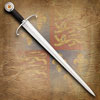 |
|
| King Henry V Sword Windlass (501780) |
Points: 20


|
King Henry V Sword was designed to be a superb weapon - simple, practical, and of high quality. The enormous, thick pommel looks misleadingly heavy, but is actually hollow. The raised rims on either side were brazed onto an inner iron disc. The recesses in the pommel were gilded with gold and accentuated with painted red crosses at the time of the king's funeral.
|
|
|
|
|
|
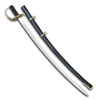 |
|
| Nasville Plow Cavalry Sabre Windlass (501152) |
Points: 12


|
This fine saber has a 1065 high carbon steel blade with full tang and is well tempered. A rare chance to own a unique piece of US wartime history. An authentic replica of the highest caliber. Prior to the Civil War Messrs. Sharp & Hamilton operated a farming implement company under the trade name of Nashville Plow Works..
|
|
|
|
|
|
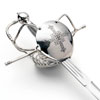 |
|
| Windlass Musketeer Rapier Sword 1590 |
Points: 20


|
Our Musketeer rapier is fashioned after those circa 1590. The basket hilt is ambidextrous and a very effective mix of both the cup-hilt and swept-hilt styles. The grip is wood wrapped with twisted wire and the parts of the hilt are plated with gleaming nickel silver.
|
|
|
|
|
|
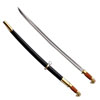 |
|
| Windlass Russian Shasqua (501074.1) |
Points: 12


|
Known originally as a Cossack cavalry weapon, this Russian Shasqua was later adopted as the official officer’s sword of the Soviet Union. The single‐edged, moderately curved blade is forged from tempered high‐carbon steel for strength.
|
|
|
|
|
|
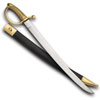 |
|
| Windlass French Napoleonic Briquet Short Sword (501867) |
Points: 10


|
This short saber was introduced in 1767, preceding the French Revolution, as a replacement for heavier and cumbersome swords like the fusilier’s ēpēe. It was instantly derided for its modest dimensions and nicknamed “Briquet” (”fire lighter”) and the name stuck and became official in 1806.
|
|
|
|
|
|
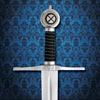 |
|
| Medieval Sword of Robert the Bruce (501495) |
Points: 10

|
Medieval Sword of Robert the Bruce. Inspired by the King of the Scots, Robert the Bruce, this sword has the Cross of St. Andrew set in the pommel. Hand forged 1065 high carbon steel comprises the blade. Overall: 43-1/2″ this sword dates circa 1300 and is made as seen in the film Robert the Bruce!
|
|
|
|
|
|
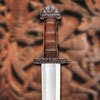 |
|
| Ashdown Viking sword (501561) |
Points: 10

|
Ashdown Viking sword. The cross guard is richly decorated with raised knots. Both the guard and the head are made of steel and have been darkened to give an antique finish. Soft leather covers the wooden handle. The set includes a leather scabbard with a matching belt, which has a very decorative metal fitting.
|
|
|
|
|
|
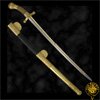 |
|
| Hanwei Charlemagne Saber (SH2288) |
Points: 30

|
The "Saber of Charlemagne the Great" is a vital part of European history, being an important artifact in the Insignia of the Holy Roman Empire, of which Charlemagne was the first Emperor. The saber is housed today, together with the rest of the imperial insignia, in the Kunsthistoriches Museum in Vienna. The sword is of Eastern European origin, dating from the first half of the 10th century. How it became a part of the insignia is not known but its lavish decoration indicates that it was made for an important member of the nobility. It is clearly a cavalry saber, indicative of its origins in the Eurasian Steppes.
CAS Hanwei's version of the saber is faithful in detail to the weapon as it was conceived, even to the point of omitting the decorative 15th century repairs that render the original unusable.
|
|
|
|
|
|
 |
|
| Hanwei Scottish Claymore (SH2060) |
Points: 12

|
Mainstay of the Highland warriors of the late 15th and 16th centuries, the Claymore had a uniquely styled hilt that sets it apart from other great swords of the period. Typically of hand-and-a-half length, this versatile weapon could deliver great sweeping slashes or powerful thrusts. Replicated from a surviving museum piece our Claymore (SH2060) is classic in its design, with distinctive sloping quillons terminating in quatrefoils and a high-collared quillon block with langets following the blade fuller. The leather-covered grip is topped by a globate pommel. Originally carried slung on the back, the Claymore matches perfectly with our OL1038B back scabbard.
Authentic styling
Fully functional
Excellent balance
|
|
|
|
|
|
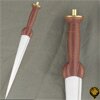 |
|
| Hanwei Scottish Dirk (SH2363) |
Points: 8
|
The ever-popular Early Dirk is strikingly authentic, its clean lines and carved hardwood hilt making it a clansman re-enactor favorite. Iberia Swords are crafted in much the same way as swords were made centuries ago, except that the blades are now forged from high-carbon spring steel, a resource unavailable off-the-shelf to the smiths of the old. The blade finish is far from being polished, again more closely replicating what the medieval swordsmith was able to achieve. Except as noted, grips are leather-covered hardwood. Fittings are either steel or solid brass. Except, where shown all of these swords have scabbards of leather-covered fiberglass with steel lockets and chapes and removable suspension rings. These swords will appeal to the re-enactor who wants a sword with the same appearance as the originals.
|
|
|
|
|
|
 |
|
| Hanwei Scottish Court Sword (SH1214) |
Points: 12

|
Quick and elegant describe the Scottish Court Sword. Replicating an original dating from the 1730's and belonging to an officer in Prince Charles Edward Stuart's army at Culloden, the finely chiseled silver-plated hilt and three-edged hollow ground blade exemplify the consummate skill of the swordsmiths of the period. See model SH2324 for the Practical Fencing Court Sword.
|
|
|
|
|
|
 |
|
| Hanwei Scottish Basket Hilt Backsword (SH2003) |
Points: 24
|
Early highland swords almost invariably carried the double-edged "broadsword" blade, but by the time of the Battle of Culloden (1746) the single-edged "backsword" was at least equal in popularity.Our Basket-Hilt Backsword, replicated from an original in the collection of the Royal Armouries in England that dates from about 1760, has an unusual basket with twin engraved "horned beastie" plaques and a blade with twin fullers running most of its length. The blade is German in origin, but the hilt and blade are contemporary.
|
|
|
|
|
|
 |
|
| Hanwei Scottish Claymore (SH2060N) |
Points: 18
|
Mainstay of the Highland warriors of the late 15th and 16th centuries, the Claymore had a uniquely styled hilt that sets it apart from other great swords of the period. Typically of hand-and-a-half length, this versatile weapon could deliver great sweeping slashes or powerful thrusts. Replicated from a surviving museum piece our Claymore is classic in its design, with distinctive sloping quillons terminating in quatrefoils and a high-collared quillon block with langets following the blade fuller. The leather-covered grip is topped by a globate pommel. The sword is available in both polished and antiqued finishes, the finish of the SH2060N closely replicating that of the original museum piece. The grips of the Claymore are leather-covered, black in the case of the SH2060 and brown for the SH2060N. Originally carried slung on the back, the Claymore matches perfectly with our OL1038/OL1038B back scabbard.
|
|
|
|
|
|
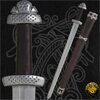 |
|
| Hanwei Trondheim Viking (SH2296) |
Points: 40

|
Hanwei continues to push the envelope with its forging capability in the Trondheim sword, produced as a one-piece forging in pattern-welded high-carbon steel. Patterned after swords that have been discovered in the area around Trodheim, Norway, the sword exhibits early ninth-century styling, a time when the Norwegian Vikings were pillaging Britain and Ireland. The beauty of the blade is matched by the grip and scabbard, both of which are wrapped in top-grain leather, engraved in a classic Viking motif.
|
|
|
|
|
|
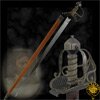 |
|
| Hanwei Cromwell Sword (SH1049) |
Points: 15

|
Oliver Cromwell (1599 - 1658) was a powerful figure in English history during and after the English Civil War, when he rose from the rank of Captain of Horse to Lord Protector of England. His sword, said to have been carried at the battle of Drogheda in 1649, has been remarkably well preserved and features in the collection of the Royal Armouries in Leeds, England, where it is displayed in the permanent collection. Our Cromwell Sword is an accurate replica of the original "mortuary" hilt style and features a blackened guard decorated in a gold foliage pattern with a wire-wound sharkskin grip. As the original sword now lacks a scabbard , we have provided a design typical of the period. This piece of English history is a must for the ECW collector and re-enactor.
|
|
|
|
|
|
|
|
Tags:
swords, sword, katana, wakizashi, tanto, japanese sword, medieval sword, viking sword, japanese swords, medieval swords, viking swords, knife, knives, saber, armour, movie swords, movie replicas, martial arts, sporting goods, sporting equipment,
|

















